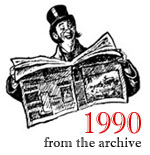
Lewis Mumford & the Humanized Habitat
Lewis Mumford, the great social philosopher, died in January of this year. He was 94. He wrote about megamachines. These are great labor machines which were created when human beings were detached from their families and communities to be made replaceable parts of a mechanized entity that could be manipulated at command. They appeared all over the world: in Mesopotamia, India, China, Yucatan, Peru, Egypt. The armies of powerful rulers were the models of megamachines, and they built monuments like the Seven Wonders of the ancient world.
Mumford contrasted two technologies, one appearing in a landscape not totally conquered by man, and the other dominating urban centers. He called the first democratic and dispersed, and the other totalitarian and centralized. Democratic technology was kept alive in innumerable villages, and its foundation was small-scale handicraft operations. The spinal principle of this democratic technology, said Mumford, “is the perception that the traits and needs and interests that all men share have a superior claim to those put forward by any special organization, institution or group.”
As soon as large numbers of people are involved together in centers of population, this democracy of common needs is threatened by those who urge centralized control. The alternative to centralization is delegated authority and co-operative organization.
With democratic techniques, the only occupation that demands a lifetime’s attention is that of becoming a full human being. People deliberately bring the ceremonies they inherit, the food they plant and harvest, and the images they carve or paint to higher degrees of aesthetic perfection. Every part of life is one’s vocation. Wherever this pattern of life has prevailed, from the neolithic village to an enclave in the modern city, humans are at home.
You May Also Enjoy
A review of Unborn Human Life and Fundamental Rights: Leading Constitutional Cases Under Scrutiny, edited by Pilar Zambrano and William L. Saunders.
A More Imperfect Bible?... From Stockboy to Stockholder... Weiner Ban... Fly Me to the Moon... Practice Makes Perfect?... The New Underground Music Scene... Super Santa... The Slapper... Your 2012 Word of the Year
Islamic Anti-Semitism & the Culture of Hate... Pro-lifers, You've Been Played

